Abstract
Variable fluorescence of chlorophyll (CF) of the photosynthetic apparatus is an ample source of valuable information on physiological condition of photosynthetic organisms. Currently, the most widespread CF-based technique is represented by recording pulse-amplitude modulated (PAM) induction of CF by saturating light. The CF-based monitoring techniques are increasingly employed for characterization of performance and stress resilience of microalgae in microalgal biotechnology. Analysis of CF induction curves reveals the fate of light energy absorbed by photosynthetic apparatus, the proportions of the energy that have been utilized for photochemistry (culture growth), and heat dissipated by photoprotective mechanisms. Hence CF and its derived parameters are an accurate proxy of the metabolic activity of the photosynthetic cell and the engagement of photoprotective mechanisms. This information is a solid foundation for making decisions on the microalgal culture management during the lab-scale and industrial-scale cultivation. Applications of CF and PAM include the monitoring of stressor (high light, nutrient deprivation, extreme temperatures, etc.) effects for assessment of the culture robustness. It also serves as a non-invasive express test for gauging the effect of assorted toxicants in microalgae. This approach is becoming widespread in ecological toxicology and environmental biotechnology, particularly for bioprospecting strains capable of the destruction of dangerous pollutants such as pharmaceuticals. In the review, we discuss the advantages and drawbacks of using CF-based methods for assessment of the culture conditions. Special attention is paid to the potential caveats and applicability of different variations of CF and PAM measurements for solving problems of microalgal biotechnology.


Adapted from Solovchenko et al. (2014b)
Similar content being viewed by others
References
Abu-Ghosh S, Dubinsky Z, Banet G, Iluz D (2018) Optimizing photon dose and frequency to enhance lipid productivity of thermophilic algae for biofuel production. Bioresource Technol 260:374–379. https://doi.org/10.1016/j.biortech.2018.03.110
Abu-Ghosh S, Fixler D, Dubinsky Z, Solovchenko A, Zigman M, Yehoshua Y, Iluz D (2015) Flashing light enhancement of photosynthesis and growth occurs when photochemistry and photoprotection are balanced in Dunaliella salina. Eur J Phycol 50:469–480. https://doi.org/10.1080/09670262.2015.1069404
Antal T (2018) The metabolic acclimation of Chlamydomonas reinhardtii to depletion of essential nutrients: application for hydrogen production. In: (Seibert M, Torzillo G, eds) Microalgal hydrogen production: achievements and perspectives. Royal Society of Chemistry 16 235–264. https://doi.org/10.1039/9781849737128-00235
Antal T, Konyukhov I, Volgusheva A, Plyusnina T, Khruschev S, Kukarskikh G, Goryachev S, Rubin A (2019) Chlorophyll fluorescence induction and relaxation system for the continuous monitoring of photosynthetic capacity in photobioreactors. Physiol Plant 165:476–486. https://doi.org/10.1111/ppl.12693
Antal T, Matorin D, Ilyash L, Volgusheva A, Osipov V, Konyuhov I, Krendeleva T, Rubin A (2009) Probing of photosynthetic reactions in four phytoplanktonic algae with a PEA fluorometer. Photosynth Res 102:67–76. https://doi.org/10.1007/s11120-009-9491-6
Brodie J et al (2017) The algal revolution. Trends Plant Sci 22:726–738. https://doi.org/10.3389/fpls.2020.609993
Chekanov K, Lukyanov A, Boussiba S, Aflalo C, Solovchenko A (2016) Modulation of photosynthetic activity and photoprotection in Haematococcus pluvialis cells during their conversion into haematocysts and back. Photosynth Res 128:313–323. https://doi.org/10.1007/s11120-016-0246-x
Chekanov K, Schastnaya E, Neverov K, Leu S, Boussiba A, Zarka A, Solovchenko A (2019) Non-photochemical quenching in the cells of the carotenogenic chlorophyte Haematococcus lacustris under favorable conditions and under stress. Biochim Biophys Acta (BBA)-General Subjects 1863:1429–1442. https://doi.org/10.1016/j.bbagen.2019.05.002
Chekanov K, Schastnaya E, Solovchenko A, Lobakova E (2017) Effects of CO2 enrichment on primary photochemistry, growth and astaxanthin accumulation in the chlorophyte Haematococcus pluvialis. J Photochem Photobiol b: Biol 171:58–66. https://doi.org/10.1016/j.jphotobiol.2017.04.028
Fallah Z et al (2021) Toxicity and remediation of pharmaceuticals and pesticides using metal oxides and carbon nanomaterials. Chemosphere 275:130055. https://doi.org/10.1016/j.chemosphere.2021.130055
Garab G, Ughy B, Goss R (2016) Role of MGDG and non-bilayer lipid phases in the structure and dynamics of chloroplast thylakoid membranes. Subcell Biochem 86:127–157. https://doi.org/10.1007/978-3-319-25979-6_6
Goltsev VN et al (2016) Variable chlorophyll fluorescence and its use for assessing physiological condition of plant photosynthetic apparatus. Russ J Plant Physiol 63:869–893. https://doi.org/10.1134/S1021443716050058
Grechanik V, Romanova A, Naydov I, Tsygankov A (2020) Photoautotrophic cultures of Chlamydomonas reinhardtii: sulfur deficiency, anoxia, and hydrogen production. Photosynth Res 143(3):275–286. https://doi.org/10.1007/s11120-019-00701-1
Grechanik V, Naidov I, Bolshakov M, Tsygankov A (2021) Photoautotrophic hydrogen production by nitrogen-deprived Chlamydomonas reinhardtii cultures. Int J Hydrogen Energy 46(5):3565–3575. https://doi.org/10.1016/j.ijhydene.2020.10.215
Grzesiuk M, Spijkerman E, Lachmann SC, Wacker A (2018) Environmental concentrations of pharmaceuticals directly affect phytoplankton and effects propagate through trophic interactions. Ecotoxicol Environ Safety 156:271–278. https://doi.org/10.1016/j.ecoenv.2018.03.019
Hanelt D (2018) Photosynthesis assessed by chlorophyll fluorescence. In: Häder D-P, Erzinger GS (eds) Bioassays. Elsevier, pp 169–198. https://doi.org/10.1016/B978-0-12-811861-0.00009-7
Havlik I, Beutel S, Scheper T, Reardon KF (2022) On-line monitoring of biological parameters in microalgal bioprocesses using optical methods. Energies 15:875. https://doi.org/10.3390/en15030875
Havlik I, Lindner P, Scheper T, Reardon KF (2013) On-line monitoring of large cultivations of microalgae and cyanobacteria. Trends Biotechnol 13:406–414. https://doi.org/10.1016/j.tibtech.2013.04.005
Havlik I, Scheper T, Reardon K (2015) Monitoring of microalgal processes. Advances in biochemical engineering/biotechnology. Springer, Berlin Heidelberg, pp 1–54. https://doi.org/10.1007/10_2015_328
Ihnken S, Eggert A, Beardall J (2010) Exposure times in rapid light curves affect photosynthetic parameters in algae. Aquatic Bot 93:185–194. https://doi.org/10.1016/j.aquabot.2010.07.002
Jin X et al (2020) High-Throughput Estimation of Crop Traits: a Review of Ground and Aerial Phenotyping Platforms. IEEE Geoscience and Remote Sensing Magazine. https://doi.org/10.1109/mgrs.2020.2998816
Juergens MT et al (2015) The regulation of photosynthetic structure and function during nitrogen deprivation in Chlamydomonas reinhardtii. Plant Physiol 167:558–573. https://doi.org/10.1104/pp.114.250530
Kalaji H et al (2014) Frequently asked questions about in vivo chlorophyll fluorescence: practical issues. Photosynth Res 122:121–158. https://doi.org/10.1007/s11120-014-0024-6
Kalaji HM et al (2017) Frequently asked questions about chlorophyll fluorescence the sequel. Photosynth Res 132:13–66. https://doi.org/10.1007/s11120-016-0318-y
Kanwugu ON, Glukhareva TV, Danilova IG, Kovaleva EG (2021) Natural antioxidants in diabetes treatment and management: prospects of astaxanthin. Crit Rev Food Sci Nutr 1-24. https://doi.org/10.1080/10408398.2021.1881434
Kramer DM, Johnson G, Kiirats O, Edwards GE (2004) New fluorescence parameters for the determination of QA redox state and excitation energy fluxes. Photosynth Res 79:209–218. https://doi.org/10.1023/B:PRES.0000015391.99477.0d
Kugler A et al (2019) Long-chain polyunsaturated fatty acids in the green microalga Lobosphaera incisa contribute to tolerance to abiotic stresses. Plant Cell Physiol 60:1205–1223. https://doi.org/10.1093/pcp/pcz013
Mallick N (2006) Immobilization of microalgae. In Methods in biotechnology 22:373–391. https://doi.org/10.1007/978-1-59745-053-9_12
Martínez-Roldán AJ, Perales-Vela HV, Cañizares-Villanueva RO, Torzillo G (2013) Physiological response of Nannochloropsis sp. to saline stress in laboratory batch cultures. J Appl Phycol 26:115–121. https://doi.org/10.1007/s10811-013-0060-1
Mata TM, Martins AA, Caetano NS (2010) Microalgae for biodiesel production and other applications: a review. Renew Sustain Energy Rev 14:217–232. https://doi.org/10.1016/j.rser.2009.07.020
Maxwell K, Johnson G (2000) Chlorophyll fluorescence—a practical guide. J Exp Bot 51:659–668. https://doi.org/10.1093/jxb/51.345.659
Minhas AK, Hodgson P, Barrow CJ, Adholeya A (2016) A review on the assessment of stress conditions for simultaneous production of microalgal lipids and carotenoids. Front Microbiol 7:546. https://doi.org/10.3389/fmicb.2016.00546
Minyuk G, Dantsyuk N, Chelebieva E, Chubchikova I, Drobetskaya I, Solovchenko A (2019) The effect of diverse nitrogen sources in the nutrient medium on the growth of the green microalgae Chromochloris zofingiensis in the batch culture. Marine Biological Journal 4:41–52. https://doi.org/10.21072/mbj.2019.04.4.04
Minyuk GS et al (2016) pH and CO2 effects on Coelastrella (Scotiellopsis) rubescens growth and metabolism. Russ J Plant Physiol 63:566–574. https://doi.org/10.1134/S1021443716040105
Mohana S, Acharya BK, Madamwar D (2009) Distillery spent wash: treatment technologies and potential applications. J Hazard Material 163:12–25. https://doi.org/10.1016/j.jhazmat.2008.06.079
Muñoz R, Guieysse B (2006) Algal-bacterial processes for the treatment of hazardous contaminants: a review. Water Res 40:2799–2815. https://doi.org/10.1016/j.watres.2006.06.011
Perri K, Manning S, Watson S, Fowler N, Boyer G (2021) Dark adaptation and ability of pulse-amplitude modulated (PAM) fluorometry to identify nutrient limitation in the bloom-forming cyanobacterium, Microcystis aeruginosa (Kützing). J Photochem Photobiol b: Biol 219:112186. https://doi.org/10.1016/j.jphotobiol.2021.112186
Plyusnina TY et al (2020) Gradual changes in the photosynthetic apparatus triggered by nitrogen depletion during microalgae cultivation in photobioreactor. Photosynthetica 58:443–451. https://doi.org/10.32615/ps.2020.002
Porcar-Castell A et al (2021) Chlorophyll a fluorescence illuminates a path connecting plant molecular biology to Earth-system science. Nat Plants 7:998–1009. https://doi.org/10.1038/s41477-021-00980-4
Ptushenko VV et al (2021) The effect of chilling on the photosynthetic apparatus of microalga Lobosphaera incisa IPPAS C-2047. Biochem Mosc 86:1590–1598. https://doi.org/10.1134/S0006297921120087
Ptushenko VV, Solovchenko AE (2016) Tolerance of the photosynthetic apparatus to acidification of the growth medium as a possible determinant of CO2-tolerance of the symbiotic microalga Desmodesmus sp. IPPAS-2014. Biochem Mosc 81:1531–1537. https://doi.org/10.1134/S0006297916120142
Skjånes K, Rebours C, Lindblad P (2012) Potential for green microalgae to produce hydrogen, pharmaceuticals and other high value products in a combined process. Crit Rev Biotechnol 33:172–215. https://doi.org/10.3109/07388551.2012.681625
Solovchenko A, Chivkunova O, Sun WJ, Merzlyak M (2012) Reconstruction of microalgal suspension absorption spectra from reflectance spectra of the cells deposited on GF/F filters. Israel J Plant Sci 60:231–242. https://doi.org/10.1560/IJPS.60.1-2.231
Solovchenko A et al (2015) A novel CO2-tolerant symbiotic Desmodesmus (Chlorophyceae, Desmodesmaceae): acclimation to and performance at a high carbon dioxide level. Algal Res 11:399–410. https://doi.org/10.1016/j.algal.2015.04.011
Solovchenko A, Khozin-Goldberg I (2013) High-CO2 tolerance in microalgae: possible mechanisms and implications for biotechnology and bioremediation. Biotechnol Lett 35:1745–1752. https://doi.org/10.1007/s10529-013-1274-7
Solovchenko A, Khozin-Goldberg I, Recht L, Boussiba S (2011) Stress-induced changes in optical properties, pigment and fatty acid content of Nannochloropsis sp.: implications for non-destructive assay of total fatty acids. Marine Biotechnol 13:527–535. https://doi.org/10.1007/s10126-010-9323-x
Solovchenko A, Khozin I, Chivkunova O (2011) Real-time spectral techniques for detection of the buildup of valuable compounds and stress in microalgal cultures: implications for biotechnology. In: Johansen M (ed) Microalgae: biotechnology, microbiology and energy. Nova Science Publishers, Hauppauge, NY, pp 251–276
Solovchenko A, Lukyanov A, Solovchenko O, Didi-Cohen S, Boussiba S, Khozin-Goldberg I (2014) Interactive effects of salinity, high light, and nitrogen starvation on fatty acid and carotenoid profiles in Nannochloropsis oceanica CCALA 804. Eur J Lipid Sci Technol 116:635–644. https://doi.org/10.1002/ejlt.201300456
Solovchenko A, Neverov K (2017) Carotenogenic response in photosynthetic organisms: a colorful story. Photosynth Res 133:31–47. https://doi.org/10.1007/s11120-017-0358-y
Solovchenko A et al (2014) Phycoremediation of alcohol distillery wastewater with a novel Chlorella sorokiniana strain cultivated in a photobioreactor monitored on-line via chlorophyll fluorescence. Algal Res 6:234–241. https://doi.org/10.1016/j.algal.2014.01.002
Solovchenko A, Solovchenko O, Khozin-Goldberg I, Didi-Cohen S, Pal D, Cohen Z, Boussiba S (2013) Probing the effects of high-light stress on pigment and lipid metabolism in nitrogen-starving microalgae by measuring chlorophyll fluorescence transients: studies with a Δ5 desaturase mutant of Parietochloris incisa (Chlorophyta Trebouxiophyceae). Algal Res 2:175–182. https://doi.org/10.1016/j.algal.2013.01.010
Solovchenko A (2013) Physiology and adaptive significance of secondary carotenogenesis in green microalgae. Russ J Plant Physiol 60:1–13. https://doi.org/10.1134/S1021443713010081
Solovchenko A, Vasilieva S, Zaitsev P, Lukyanov A, Skripnikova E, Antal T (2022) Approaches to rapid screening of pharmaceutical xenobiotic effects on microalgae via monitoring of photosynthetic apparatus condition. J Appl Phycol 34:353–361. https://doi.org/10.1007/s10811-021-02660-4
Stirbet A, Riznichenko GY, Rubin AB, Govindjee, (2014) Modeling chlorophyll a fluorescence transient: relation to photosynthesis. Biochem Mosc 79:291–323. https://doi.org/10.1134/S0006297914040014
Strasser R, Tsimilli-Michael M, Srivastava A (2004) Analysis of the chlorophyll a fluorescence transient. In: Papageorgiou G, Govindjee (eds) Chlorophyll a fluorescence: a signature of photosynthesis. Springer, 321–362. https://doi.org/10.1007/978-1-4020-3218-9_12
Tian L, Nawrocki WJ, Liu X, Polukhina I, van Stokkum IHM, Croce R (2019) pH dependence, kinetics and light-harvesting regulation of nonphotochemical quenching in Chlamydomonas. Proc Natl Acad Sci USA 116:8320–8325. https://doi.org/10.1073/pnas.1817796116
Tsygankov A, Kosourov S (2014) Immobilization of photosynthetic microorganisms for efficient hydrogen production. In: Zannoni D, De Philippis R (eds) Microbial bioenergy: hydrogen production. Advances in Photosynthesis and Respiration. Springer Science+Business Media, Dordrecht, 38, 321–347. https://doi.org/10.1007/978-94-017-8554-9_14
Van Den Hende S, Vervaeren H, Boon N (2012) Flue gas compounds and microalgae: biochemical interactions leading to biotechnological opportunities. Biotechnol Adv 30:1405–1424. https://doi.org/10.1016/j.biotechadv.2012.02.015
Vasilieva S et al (2021) Bio-inspired materials for nutrient biocapture from wastewater: microalgal cells immobilized on chitosan-based carriers. J Water Proc Eng 40:101774. https://doi.org/10.1016/j.jwpe.2020.101774
Vítová M, Bišová K, Kawano S, Zachleder V (2015) Accumulation of energy reserves in algae: from cell cycles to biotechnological applications. Biotechnol Adv 33:1204–1218. https://doi.org/10.1016/j.biotechadv.2015.04.012
Vonshak A, Novoplansky N, Silva Benavides AM, Torzillo G, Beardall J, Palacios YM (2020) Photosynthetic characterization of two Nannochloropsis species and its relevance to outdoor cultivation. J Appl Phycol 32:909–922. https://doi.org/10.1007/s10811-019-01985-5
Zorin B et al (2017) Arachidonic acid is important for efficient use of light by the microalga Lobosphaera incisa under chilling stress. Biochim Biophys Acta (BBA)–Molecular and Cell Biology of Lipids 1862:853–868. https://doi.org/10.1016/j.bbalip.2017.04.008
Funding
Financial support of Russian Science Foundation (project 21–74-20004) is gratefully acknowledged.
Author information
Authors and Affiliations
Contributions
All authors contributed to the study conception and design. The first draft of the manuscript was written by Alexei Solovchenko and all authors commented on previous versions of the manuscript. All authors read and approved the final manuscript.
Corresponding author
Ethics declarations
Ethics approval
This article does not contain any studies with animals or human participants performed by any of the authors.
Consent to participate
Not applicable.
Consent for publication
Not applicable.
Conflict of interest
The authors declare no competing interests.
Additional information
Publisher's note
Springer Nature remains neutral with regard to jurisdictional claims in published maps and institutional affiliations.
Rights and permissions
About this article
Cite this article
Solovchenko, A., Lukyanov, A., Vasilieva, S. et al. Chlorophyll fluorescence as a valuable multitool for microalgal biotechnology. Biophys Rev 14, 973–983 (2022). https://doi.org/10.1007/s12551-022-00951-9
Received:
Accepted:
Published:
Issue Date:
DOI: https://doi.org/10.1007/s12551-022-00951-9




